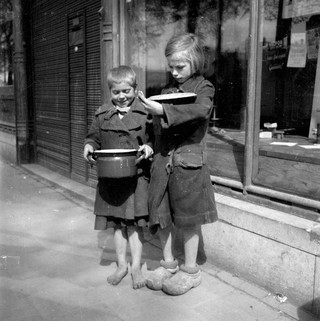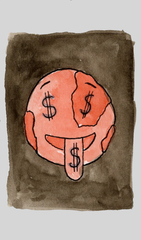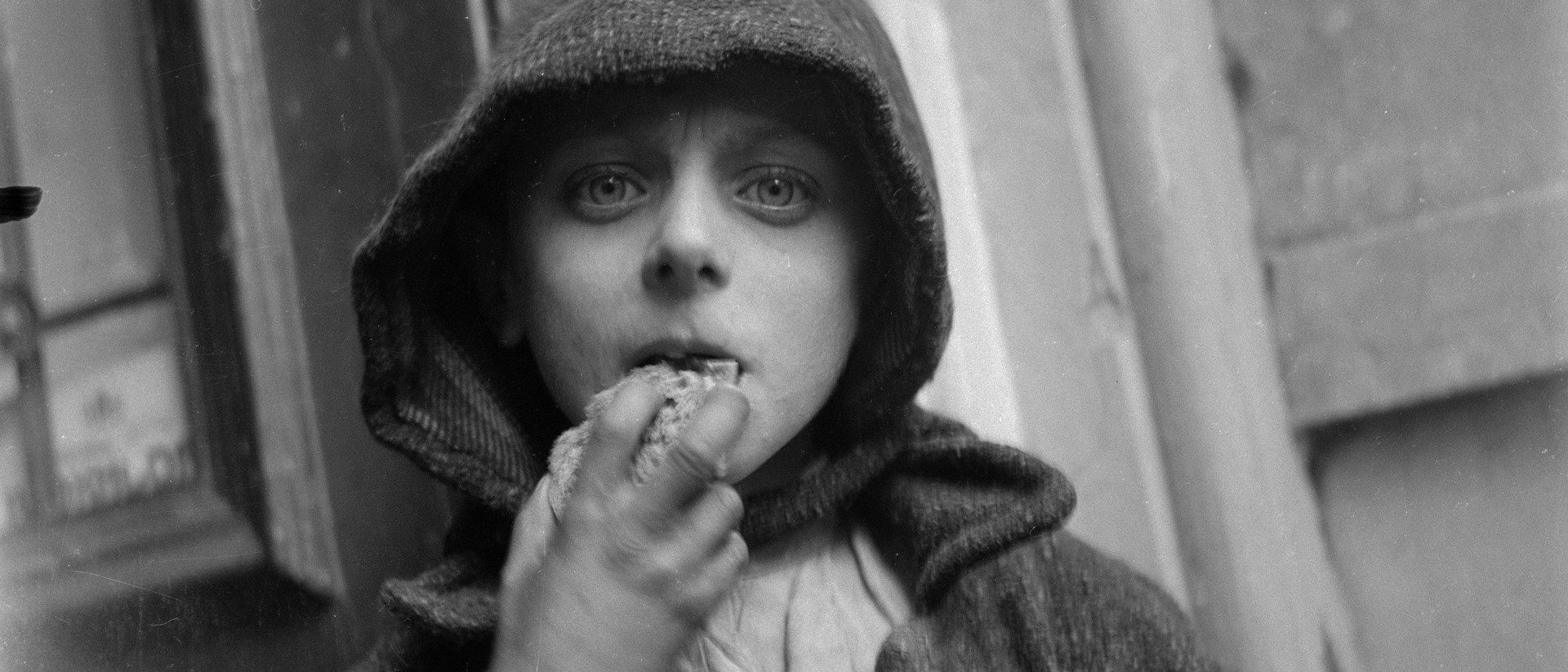Most of what we know about hunger comes courtesy of World War II. Every cloud has a silver lining. It might sound crass, but even war can accidentally leave behind things of value. For instance, the Netherlands has World War II to thank for its welfare system, as correspondent Rutger Bregman has explained.
And researchers in the Netherlands, Poland, and the United States used the war to learn about the consequences of starvation. In doing so, they gave meaning to senseless suffering and death. Seventy years later, the information they gathered is still making a valuable contribution in the fight against hunger and the effects of malnutrition.
For anyone who’s forgotten, more than 800 million people suffered from chronic malnourishment in 2015. Two billion more live with “hidden hunger”: a deficiency of vitamins and minerals like iron, iodine, zinc, and folic acid. It impedes their physical and intellectual growth, eroding their health and life expectancy.
The war taught us the dire consequences of hunger in the short and long term.
What are the stages of starvation? When does appetite become hunger? When does hunger cross over into malnutrition? When does malnutrition lead to death? And what happens to the body and mind in between?
Before World War II, scientists’ understanding of hunger and malnutrition was scant. After all, how could they study it? They could hardly allow subjects to starve without intervention: that would have been unethical.
In the Warsaw ghetto in World War II, the moral obstacles were removed. Doctors didn’t have the food or medicine needed to save their patients. War provided an ideal laboratory for studying hunger.
The ghetto doctors’ project
In fall 1940, the Germans established the Warsaw ghetto: a walled, sealed district solely for Jews. Half a million people were herded into an area of little more than one square mile. The Germans’ policy was designed to starve them from the outset. Food rationing in occupied Poland allowed Germans 2,613 calories a day, gentile Poles 699, and Jews 184 – the equivalent of a bowl of watery soup and a piece of bread.
If doctors couldn’t save their patients, at least they could learn from their agony
How much you got to eat in the ghetto depended on what you were able to buy on the black market. The richest consumed perhaps 1,700 calories a day, the poorest fewer than 800. People literally dropped dead in the streets.
The ghetto had two hospitals: Czyste and, for children, Berson and Bauman. In 1941, Czyste’s director Joseph Stein wrote that the word “hospital” might as well be scrapped from the name: it didn’t even qualify as a poorhouse. A visitor to Berson and Bauman remarked that it would be kinder not to extend the poor children’s lives.
Without medicine or food, the doctors and nurses of the ghetto could do little or nothing for patients. They were forced to stand by while the sick slowly starved to death. But if they couldn’t save their patients, at least they could learn from their agony. If future generations could benefit from knowledge gained, the looming deaths would not be entirely in vain.
In deepest secrecy, the doctors set up an ambitious study. They selected as subjects 140 patients whose primary problem was not illness but malnutrition.
Dutch famine of 1944-45, Amsterdam. Photo by Cas Oorthuys/Hollandse Hoogte

The four stages of hunger
The doctors recorded their findings in the research report, chapter by chapter. The first symptoms of hunger in adults: a dry mouth, frequent urination, rapid weight loss and an irrepressible yearning for food.
In a later phase, the craving for food became less urgent. Apathy took its place, along with a general feeling of weakness. The starving person preferred to curl up in the fetal position; he was always cold. Fluid accumulated in his cells, beginning with the face, feet, and legs. The condition became known as hunger edema.
At this stage, accelerated aging set in. Deprived of food, the young person turned elderly. Her skin grew papery: pale, dry, and scaly. Brown blotches appeared all over her body. Her hair fell out.
In the final period, the person’s movements became slow and clumsy. He was a skeleton tripping over his own feet. His heartbeat slowed; his blood pressure and body temperature dropped further. His voice grew hoarse. One of the report’s authors wrote: “Death from longlasting hunger is like a candle burning out slowly.”
Autopsies on 500 patients showed that of all the vital organs, the only one that retained its weight in the face of starvation was the brain. Muscle tissue dwindled to one-third of what it had been. Heart, liver, kidneys shriveled. An autopsy report on a 16-year-old girl noted that her heart was smaller than her fist.
The doctors presented their findings at a secret conference on July 6, 1942. Two weeks later, mass deportations from the ghetto to the death camps began. The research was hastily collected and smuggled out. In October 1942, the doctor who headed the study, Israel Milejkowski, wrote in an introduction to the report: “In spite of this, nobody interrupted the work, and quietly, modestly, without any advertising, the work was done.”
Milejkowski concluded his preface with the words “Non omnis moriar”: “I shall not wholly die.” Three months later, he was deported to the Treblinka death camp. The research report was published in France in 1946. Its scientific and historical importance was immediately recognized.
Dutch famine of 1944-45, Amsterdam. Photo by Cas Oorthuys/Hollandse Hoogte

The children of the Hongerwinter
Important information on hunger and malnutrition was amassed in the Netherlands, too, during the war. (It’s easy to take a cynical view here. Dutch hospitals kept their patient administrations in order, just as cities carefully kept their population registries up to date: it was part of what enabled the detention and deportation of record numbers of Jews in the country.)
By September 1944, the southern Netherlands had been liberated. In support of the Allied advance, the Dutch government-in-exile in London called for a national railway strike. The Germans retaliated by banning food transport by train to the urbanized west. Supplies in the cities quickly ran out. To make matters worse, the cold weather arrived early that year, and it was unusually harsh. Thus began the "Hunger Winter" – Hongerwinter – which cost an estimated 20,000 lives.
In the winter of 1944-45, the average pregnant Dutchwoman didn’t gain weight – she lost it. We know this from birth records, which paint a detailed picture of the prevailing malnutrition. The average mother-to-be weighed 150 lbs. at her initial checkup. Just before giving birth, she was down to 137 or less, even as her fetus had gained 5 lbs. in the preceding 12 weeks.
A mother’s malnutrition has lasting negative effects on her child’s health
Babies conceived and born during the Hongerwinter weighed less than those whose lives had begun in peacetime. Their bodies and heads were smaller. They were more likely to die at birth or in the first three months of life.
Dozens of research projects since the 1960s have examined birth records from the period. The most famous make up the Dutch famine birth cohort study. For 20 years and counting, researchers have been tracking the health of men and women born in winter 1944-45 at Amsterdam’s Wilhelmina Gasthuis hospital.
The findings are staggering. They show that malnutrition in a mother has lasting negative effects on her child’s health. The foundations for many illnesses – cardiovascular disease, diabetes, cancer – are laid in the womb. A baby suffers the consequences of its mother’s hunger all its life.
The effects are most severe when the mother goes without sufficient food in the first three months after conception, when vital organs like the heart, brain and liver form. Children conceived or born during the Dutch famine were more likely to encounter psychological problems, such as depression and schizophrenia. Since their bodies had learned in the womb to process nutrients as efficiently as possible, they were prone to becoming overweight later.
Children collect wood from tram rail ties, to use as fuel during the Hunger Winter in Amsterdam (1944-1945). Photo by Cas Oorthuys/Hollandse Hoogte

Voluntary starvation
Of the World War II hunger studies, an experiment at the University of Minnesota was perhaps the most unusual – first of all because there was no famine in the United States. Of course, the researchers knew about the widespread hunger in occupied Europe. They wanted to find out how best to help starving Europeans regain their health after liberation. Which nutrients in which amounts would be most effective?
But they needed starving people for the experiment. Where could they find them in a hurry? They appealed to the 42,000 Americans whose moral or religious convictions had led them to become conscientious objectors, earning them social opprobrium. Many wished to demonstrate their willingness to make sacrifices on behalf of humanity. Of hundreds of volunteers, the researchers selected the 36 most physically and mentally healthy to serve as guinea pigs.
The experiment began in November 1944 and lasted a year. The first three months were devoted to getting the volunteers to their optimum base weight. They were allowed to eat what they wanted. Each day, they put away an average 3,500 calories.
A six-month period of hunger followed. In this phase, they were given approximately 1,570 calories’ worth of food a day. The goal was to reduce their body weight by 24%.
They couldn’t regain weight
At first, the volunteers were full of energy and fascinated by the experiment. As hunger set in, they became quieter and more obsessed with food. Their faces narrowed; their jaws became pronounced; their buttocks shrank. They carried pillows, since sitting was painful.
Their wrists and ankles swelled up from edema, concealing their weight loss. They developed anemia and lay shivering under two blankets in the middle of a hot summer. They no longer had the strength to make their beds. They became depressed, antisocial and nervous. They lost interest in everything and became withdrawn.
Thanks to the Dutch famine, we know babies suffer the consequences of maternal malnutrition all their lives
Once the six months were up, the worst appeared to be over. The three-month recovery period began. The volunteers’ daily ration was raised to between 2,000 and 3,000 calories. After five weeks, though, they looked no less skeletal. They had gained little or no weight. They still felt tired and depressed. Their blood pressure and pulse rates remained low. And they were still hungry – some more so than ever.
Their food intake was increased to 4,000 calories a day. Slowly, the men began to recover. Their heart and lung capacity increased, but much more slowly than the researchers had expected. Vitamin and protein supplements had no effect whatsoever. At the end of the three months, none of the volunteers were anywhere near their starting weight.
They took months to recover completely. Some ate up to 10,000 calories a day. Within a year, many had become slightly overweight.
Because of the Dutch famine, we know babies suffer the consequences of maternal malnutrition all their lives. From the Warsaw ghetto, we know in detail how starvation gradually destroys the body and mind. Thanks to the Minnesota experiment, we know that giving patients extra vitamins and protein during rehabilitation doesn’t help. Since World War II, it’s been an established scientific fact that chronic hunger inflicts lasting damage.
A quarter of the world’s population is still experiencing it firsthand every day.
Note: While writing this article, I consulted a valuable resource: Sharman Apt Russell’s authoritative Hunger: An Unnatural History (New York: Basic Books, 2005).
—Translated from Dutch by Laura Martz
More from The Correspondent:
 Poverty 101: How can we end global poverty once and for all?
By 2030 the world must be free of extreme poverty. The question is how? Of course there’s no single answer. In this crash course on global poverty, we bring together as many answers as we can. We’ll look at the extent of the problem, the causes, and possible solutions.
Poverty 101: How can we end global poverty once and for all?
By 2030 the world must be free of extreme poverty. The question is how? Of course there’s no single answer. In this crash course on global poverty, we bring together as many answers as we can. We’ll look at the extent of the problem, the causes, and possible solutions.
 Why do the poor make such poor decisions?
Our efforts to combat poverty are often based on a misconception: that the poor must pull themselves up out of the mire. But a revolutionary new theory looks at the cognitive effects of living in poverty. What does that relentless struggle to make ends meet do to people?
Why do the poor make such poor decisions?
Our efforts to combat poverty are often based on a misconception: that the poor must pull themselves up out of the mire. But a revolutionary new theory looks at the cognitive effects of living in poverty. What does that relentless struggle to make ends meet do to people?
 Why we know less about developing countries than we think
Africa boasts five of the world’s ten fastest-growing economies. And the percentage of poor and malnourished people worldwide has been cut by half in the last 25 years. Poor countries seem to be prospering – but is the rosy picture accurate? I crunched the numbers, and here’s the truth: when it comes to developing countries, there’s a lot we don’t know.
Why we know less about developing countries than we think
Africa boasts five of the world’s ten fastest-growing economies. And the percentage of poor and malnourished people worldwide has been cut by half in the last 25 years. Poor countries seem to be prospering – but is the rosy picture accurate? I crunched the numbers, and here’s the truth: when it comes to developing countries, there’s a lot we don’t know.




